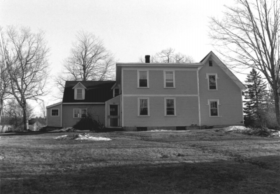Dr. Edith Marion Patch taught entomology at the University of Maine and served as director of entomology at the Maine Agricultural Experiment Station from 1903- 1937. Patch was the first woman to head a state agricultural experiment station department and was honored for her scholarship and educational leadership in 1930 by being elected president of the American Entomological Society, at a time when many scientific societies refused to admit women.
Born in Worcester, Massachusetts in 1876, Patch arrived at the University of Maine in 1903, at the age of twenty-seven. Braeside, the Edith Marion Patch House in Old Town,was built around 1837. From 1913 to 1954 Braeside was the home of the internationally recognized scientist. A graduate of one of the first coeducational universities in America, University of Minnesota, Patch was one of the few women of her day to hold an academic specialization in entomology. For two years after college she struggled to find work in her discipline. After two years of supporting herself by high school teaching, Patch was invited to come to Orono by Charles D. Woods, Director of the Maine Agricultural Experiment Station.
Though his critics scoffed that Miss Patch wouldn’t be able to climb trees or catch grasshoppers, he hired her anyway, to start an entomology department. No funds were approved for her position, so Patch had to work a year without salary to prove herself. The next year, having created an entomology department and mapped out its research agenda, Patch was granted the paid position of entomologist. She became the first woman in the nation to head an experiment station and devoted the rest of her professional life to the University of Maine. Patch earned her Master’s degree from the University of Maine in 1910, and her Ph.D. from Cornell in the following year. She published more than eighty technical reports and scientific articles. The focus of her research was on aphids, which cause enormous damage to potato, timber, and other economically important plant species in Maine, the nation and the world.
In addition to her contributions to scientific research, Patch was a renowned educator and author of many books and articles for children and the general public. Her writings, popular among families, were also adopted as textbooks in elementary schools around the country. Her work as a writer and educator was honored by her election, twice, to the presidency of the American Nature Study Society, the nation’s leading science education organization. Patch’s effort to integrate scientific research and public education are evident in her early calls for ecological awareness. A generation ahead of Rachel Carson, she warned of the dangers of chemical pesticides, and used both her popular writings and her work with farmers to demonstrate more ecologically appropriate forms of pest control. [Martha McNamara photo]
Additional resources
Text, photo and references from the Maine Historic Preservation Commission’s nomination to the National Register of Historic Places.
https://npgallery.nps.gov/pdfhost/docs/nrhp/text/01001269.PDF (accessed June 10, 2018)
Day, Clarence Albert. Historical Sketch of Orono. Orono, Maine: 1956.
Norton, David. Sketches of Old Town and Orono. Orono, Maine: 1898.
Rogers, Hanna. A History of Orono, Maine. Orono, Maine: 1926.
Smith, David C. The First Century: A History of the University of Maine, 1865-1965. Orono: University of Maine Press, 1979.


